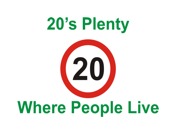
Streetfilms has a new video on 20’s Plenty for us, a campaign in the U.K. working to make 20 mph the standard speed limit in residential areas. The campaign is catching on quickly, with more and more U.K. cities adopting the policy all the time. Given that PBOT might be considering a legislative fix to wrest greater control of speed limits from ODOT, and the fact that Mayor Sam Adams has already shown an interest in reducing speed limits and has made safety his number one transportation priority, this could be an idea that catches on here in Portland.
The 20’s plenty pitch is simple: Lower speeds make for more pleasant places to live, work, and play. Seems like everyone would agree to that. Watch the excellent video to hear how people working on the campaign pitch the idea:
A 20 mph speed limit isn’t just fodder for a catchy campaign slogan, its impact on saving lives has been confirmed by major study findings and even the World Health Organization has endorsed 20 mph speed limits. (Learn more about London’s success with 20 mph zones in this Streetsblog article.)
PBOT has used the “Effects of speed on stopping distance” chart (see it below) in neighborhood meetings and presentations for at least five years now (I first published it in 2005). It shows that 20 mph is the maximum speed at which someone can operate a motor vehicle and still stop in time to avoid hitting someone…

The Streetfilms piece also reminded me of a law that passed in 2007 but that I’ve not heard much about since (thanks to reader Robin Dale for bringing it to my attention again). In the 2007 legislative session, State Rep. Carolyn Tomei sponsored a bill (H.B. 2297) that defined a “narrow residential roadway” as any street “not more than 18 feet wide at any point between two intersections or between an intersection and the end of the roadway” and “Not of sufficient width to allow one lane of traffic in each direction.” The bill amended Oregon’s basic speed rule so that all such roadways could have a maximum speed limit of just 15 mph. Unfortunately, it seems that there aren’t many streets that fit that bill and it seems to have had little impact thus far.
Here in Portland, most residential streets have a 25 mph speed limit and many streets which run through highly residential areas (like N. Rosa Parks Way for instance) have speed limits of 35 mph.
One way I can imagine PBOT approaching new speed limit laws and policies is to legally leverage the “neighborhood greenway” concept. Neighborhood greenways are PBOT’s new name for bike boulevards, which are “family-friendly,” residential streets where people on bicycles and on foot are prioritized. Similar to how Rep. Tomei was able to define “narrow residential roadway,” PBOT could define neighborhood greenway in the ORS and then attach a 20 mph speed limit to it in Oregon’s basic speed rule. Then, any street officially classified as a neighborhood greenway would automatically have a 20 mph speed limit.
Lower speed limits — when coupled with smart engineering, focused enforcement, and a bit of marketing — would do wonders in helping create residential streets where everyone feels safe and welcome.
— Read more of BikePortland’s coverage of this topic by browsing our “speed” story tag.

